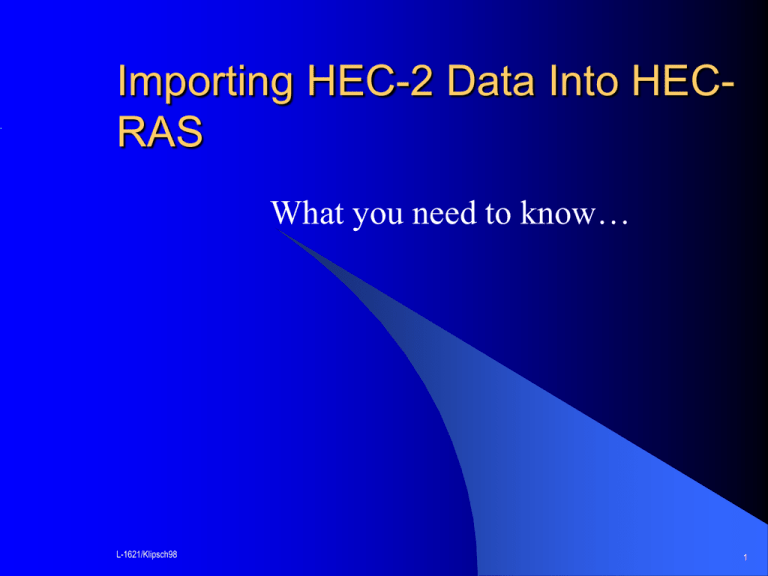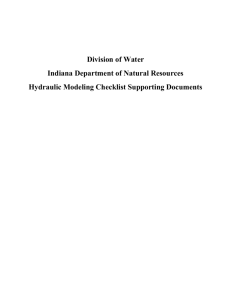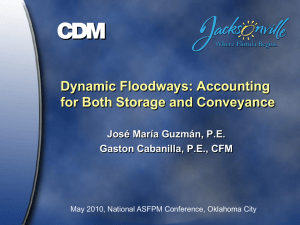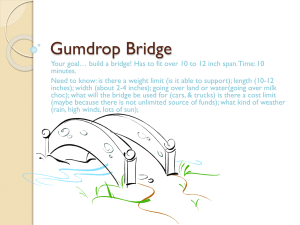Importing HEC-2 Data into HEC-RAS
advertisement

Importing HEC-2 Data Into HECRAS What you need to know… L-1621/Klipsch98 1 What you should know first… Not all HEC-2 options have a parallel in HEC-RAS Computation of Manning’s n values from high watermarks. Archiving (AC) Free format (FR) These options are ignored by the importer, so data sets which contain them can still be imported. Some HEC-2 options are available, but are not imported L-1621/Klipsch98 Split flow Vertical variation of Manning’s n values Storage outflow for HEC-HMS 2 All imported data should be reviewed carefully for accuracy and completeness, especially... Special bridges (SB) and culverts (SC) Normal bridges (X2, BT) Encroachments and floodway determination (X3, ET) Ineffective flow areas (X3) Channel improvements and modifications (CI) How the HEC-2 cross sections are Identified… L-1621/Klipsch98 By river mile or station? By an arbitrary numbering scheme? Are the section ID numbers increasing from downstream to upstream? Are there duplicate section ID numbers? 3 The Import Process – Step 1 Create a new project … L-1621/Klipsch98 4 Give your new project a title and a unique file name … Confirm your title and file name… L-1621/Klipsch98 5 The Import Process – Step 2 After a new project has been opened, select Import HEC-2 data… from the File menu. L-1621/Klipsch98 6 Select the HEC-2 file to be imported… Tell HEC-RAS how to identify the cross sections as they are imported… L-1621/Klipsch98 7 Use the Geometry and Steady Flow Editors to review the imported data*. – The note below will appear whenever an HEC-2 data set that contains bridge or culvert data is imported. This is a reminder that bridges and culverts are not handled in the same way in HEC-RAS as they are in HEC-2. You will need to check that the data has been interpreted correctly. L-1621/Klipsch98 8 Computational Differences between HEC2 & HEC-RAS Cross Section Conveyance Calculations Critical Depth Calculations Bridge Hydraulics L-1621/Klipsch98 9 • Cross Section Conveyance Calculations – HEC-RAS Method: subdivisions at n-value break points. n1 A1 P1 n2 A2 P2 n3 Ach Pch Klob = K1 + K2 n4 A3 P3 Krob = K3 Kch L-1621/Klipsch98 10 – HEC-2 Method: subdivisions at every ground point. n1 A2P2 n3 n2 A3 P3 A4 P4 Ach Pch n4 A5 P5 A6 P6 A7 P7 A1 P1 A8 P8 Krob = K5 + K6 + K7 + K8 Klob = K1 + K2 + K3 + K4 Kch L-1621/Klipsch98 11 – To choose the conveyance subdivision method to use, select Steady Flow Analysis… from the Simulate menu: L-1621/Klipsch98 12 – Select Conveyance Calculations… from the Options menu of the Steady Flow Analysis editor – And select your method… L-1621/Klipsch98 13 • Critical Depth Calculations HEC-RAS – Parabolic Method – Secant Method Used if parabolic method… Does not converge. Finds a value at the top of a levee or at an ineffective flow elevation. L-1621/Klipsch98 HEC-2 – Parabolic Method Uses first local minimum it finds. 14 – To choose, first select Critical Depth Computation Method… from the Options menu of the Steady Flow Analysis editor: – Then select the method: L-1621/Klipsch98 15 • Bridge Hydraulics HEC-RAS – 4 Low Flow Methods Energy Momentum Yarnell WSPRO – 2 Independent High Flow Methods L-1621/Klipsch98 Energy Pressure &/or Weir HEC-2 – 2 Low Flow Methods Normal (Energy) Special (Yarnell) – 2 High Flow Methods dependent upon Low Flow Method Energy Pressure & Weir 16 • HEC-2’s Special Bridge Method – Low Flow HEC-RAS – All methods (including Yarnell’s) use actual bridge geometry to determine flow area – Each pier is defined and located individually – Bridge opening is determined by geometry. L-1621/Klipsch98 HEC-2 – Trapezoidal approximation of bridge opening used to determine flow area – Single equivalent width pier centered within trapezoid – Net flow area input for pressure flow. 17 • HEC-2’s Special Bridge Method – Pressure Flow HEC-RAS – Fully submerged or upstream-only submerged. – Bridge opening based on geometry. – Weir profile is the union of the cross section and bridge deck. L-1621/Klipsch98 HEC-2 – Fully submerged condition assumed – Net flow area input for pressure flow. – Weir profile is defined by BT or X2 data – not cross section. 18 • HEC-2’s Normal Bridge Method HEC-RAS – Piers are defined separate from the deck or ground. – The deck data must have a spatial relationship to the cross section(s) but need not match ground points. L-1621/Klipsch98 HEC-2 – Piers were defined as part of the cross section data or deck data. – Each BT data point was required to match a cross section GR point. 19 • Culvert Hydraulics HEC-RAS HEC-2 – Wide variety of shapes available: Box Pipe Arch – Pipe – Low & High Profile – ConSpan – 2 Shapes available: Box Pipe – Multiple barrels of only one shape and size can be used at a single crossing. Ellipse – Vertical – horizontal – Multiple culverts of different shapes and sizes can be placed at a single crossing. L-1621/Klipsch98 20 • Floodway Determination HEC-RAS – Methods 1-3 – Method 4 0.01 ft. accuracy – Method 5 Optimizes for Water Surface or Energy or Both. – Floodway determination is independent of blocked obstructions. L-1621/Klipsch98 HEC-2 – Methods 1-3 – Method 4 Parabolic Interpolation – Method 5 Optimizes for a change in Water Surface – Method 6 Optimizes for a change in Energy – X3 encroachments override ET floodway determination. 21 What can HEC-RAS do that HEC-2 cannot? Mixed Flow Multiple Openings Momentum computation at bridges and junctions Complex dendritic streams and looped networks Blocked Ineffective Areas Normal Ineffective Areas at any station Blocked Obstructions Levees Inline and Lateral weirs and gated spillways Geometric cross section interpolation L-1621/Klipsch98 22








